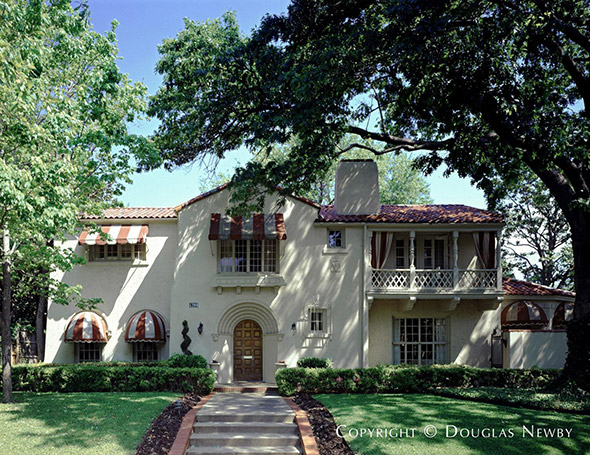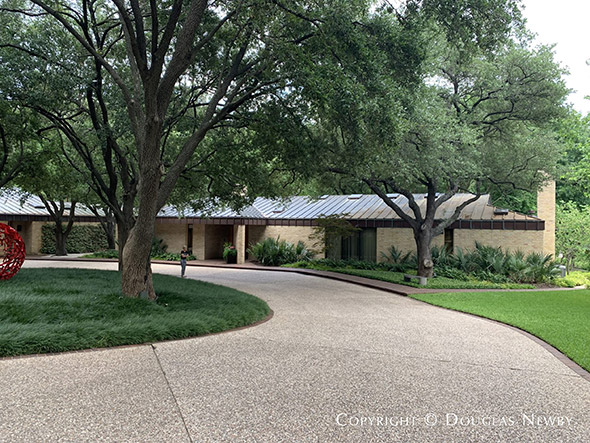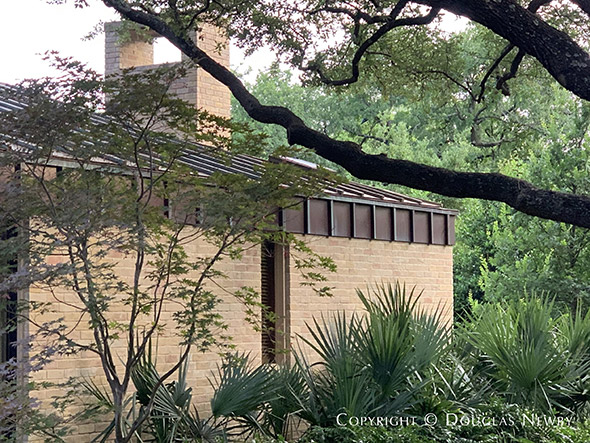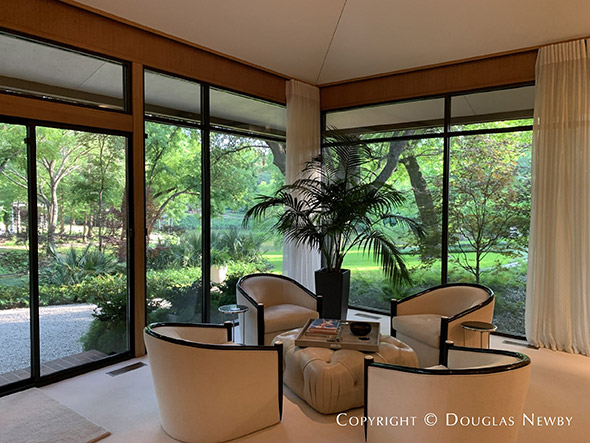
For decades, Highland Park, a wealthy older suburb two miles from downtown Dallas, homes have been torn down, however, this year this activity has accelerated. Perhaps new residents --- the great influx of home buyers from California to Dallas has exacerbated some problems, with the most troubling being the escalation of Highland Park homes in Dallas being torn down. It is not just the raw numbers of people moving to Dallas. Usually, corporate relocations move hundreds of middle level employees and a few executives. During the last two years we have seen corporate relocations, but also company owners or firm partners who are moving to Dallas but leaving their businesses in New York or California. These are the types of home buyers where money is no obstacle and if they can’t find what they want to live in, they have the resources to buy a home, tear it down and build a new one, adding to the acceleration of Highland Park teardowns.
There is no way to prevent every historic home from being torn down, but we can slow the demise of historically and architecturally significant homes. First, we need to understand why Highland Park Texas, homes are torn down.
Some Highland Park Homes are Torn Down for Good Reasons
Every decade, as our city and neighborhoods evolve, we can expect some Highland Park homes to be torn down. Some for good reason. Sometimes we are put out of our architectural visual misery. Some of the homes torn down are not architect-designed homes from the 1920s, but a builder home from the 1970s that had replaced a good home designed 50 years earlier. It is time for some inferior homes to go. Some homes were originally very nice homes that became irrevocably mangled through stylistic renovations and additions. The architecture of the neighborhood improves when these architecturally mangled homes get torn down. Other homes, excruciatingly small, are surrounded and dwarfed by gracious large homes. On occasion, the continuity and architectural flow of the street is compromised by one outlying small house. We have seen examples of inferior or uninspired homes replaced with exceptional homes that add to the rich architectural landscape.
It is Tragic When Exquisite Homes are Torn Down—Especially for No Good Reason

Architects Fooshee & Cheek trained under architect Hal Thomson and continued to design architecturally significant homes like this one at 4208 Beverly Drive. It was torn down for no other reason than the listing agent and seller thought it would be easier to sell the property as a vacant lot. The lot was on the market for over five years before someone bought it. Many homebuyers wished for the house to remain standing as it was the perfect size for the lot and had great architectural style and merit.
On the other hand, exquisite and timeless homes designed by our best Dallas architects have been torn down for no good economic reason. These architecturally significant and historic homes have been torn down because of a lack of knowledge, lack of preservation advocacy, and teardown pressure from real estate agents, contractors, architects, and even, at times, the Township of Highland Park.
Perfect Storm for Highland Park Homes to be Torn Down
For decades, homebuyers have desired vacant properties on which to build their dream homes. But in an established neighborhood like Highland Park this requires another home to be torn down. For many years, this was not a significant problem in Highland Park. Years ago, the homes being torn down were the low-hanging fruit. These were the homes with the least aesthetic and economic value. These insignificant Highland Park homes were rarely missed, and their absence was often applauded. Better Highland Park homes often replaced inferior homes and the better homes were not outlandishly larger than the Highland Park homes torn down. But that fortunate dynamic has changed.
“Homes That Make Us Happy” Create More Demand for Land
I said five years ago in my TEDx Talk, Homes That Make Us Happy, that land and its site would become increasingly important. The pandemic --- as well as the rise of inner-city crime and the disorders of 2020 --- accelerated this prediction. Dallas residents moved from denser neighborhoods and more vibrant neighborhoods to neighborhoods with more land and a calmer environment.
Homeowners who desired a larger home desired proportionally more land which precipitated landowners assembling more than one lot for a new home. Now, a new home might require two Highland Park homes to be torn down to obtain the desired land. The multiple parks, beautiful boulevards and tree-lined streets found in Highland Park are like a magnet to those moving from the increasingly dysfunctional East Coast and West Coast cities. Despite the high prices in Highland Park, these prices were relatively modest compared to California prices. In addition, the tax savings that someone moving from Los Angeles would achieve by moving to Texas, would almost pay for a home in Highland Park. The surge of East and West Coast homebuyers created a disruptive demand for land and homes in Highland Park, causing many additional homes to be torn down.
Architecturally Significant Preston Hollow Homes are Also Being Torn Down


Architect Scott Lyons for a time worked with beloved architect O’Neil Ford. When O’Neil Ford became more involved in designing commercial buildings, art and architecture patrons like Eugene and Margaret McDermott retained Scott Lyons to design an architecturally significant home for themselves. This magnificent Texas Modern home was designed for business titan Grant Fitts with a refined aesthetic quality and commercial grade construction. The primary home was 12,000 square feet and the guest house was an additional 3,000 square feet. It had been recently renovated and landscaped. This Preston Hollow estate home at 10240 Gaywood Road in the Preston Hollow estate area was torn down in 2021.
The same phenomena can be seen in Preston Hollow, which is eight miles from the heart of downtown Dallas, and two miles north from Highland Park. Preston Hollow is an estate area where most lots have at least one acre, where in Highland most of the lots are under one acre with the majority far smaller. Preston Hollow is in the elite private school corridor whereas Highland Park has its own HPISD school district with some of the best public schools in Texas.
There have also been many architecturally significant homes in Preston Hollow that have been torn down. A perfect example is a 12,000 square foot Scott Lyons architect-designed home in perfect shape on Gaywood Road in Mayflower Estates. It was torn down because it was on 2-1/2 acres of land adjacent to homes on pretty land. These Preston Hollow Dallas homes that get torn down do not receive the same attention because the homes are spread out and do not have the same 100-year-old mystique of Highland Park.
Big Homes Torn Down Bring More Attention
We notice when big homes are torn down. Large Highland Park homes make a bigger impact than when smaller houses are torn down. California buyers, along with Dallas buyers, have an appetite for large lots. Often, the grandest old homes in Highland Park are on the grandest lots. As a result, the largest historic homes in Highland Park have always been the most vulnerable for being torn down. For generations, these grand homes have been admired and enjoyed. It is only natural when one of these architecturally significant homes and sentimental favorites are torn down in Highland Park, there is immediate Highland Park community grief.
California Homebuyers Have No Sentiment for Iconic Highland Park Homes
When someone is raised in Highland Park and every day as a child they play in an architecturally significant home or ride their bike by an architecturally or historically significant home, they develop a real affection for that house, and the whole terroir of the neighborhood. Years later, when it came time for these children in Highland Park to buy a home of their own, they would be more reluctant to tear down a home they always loved. In contrast, out-of-town buyers have no sentiment for iconic homes and no prior knowledge of the favorite homes in Highland Park, a large lot underneath the house becomes the sole focus of these buyers.
Real Estate Agents Have Never Had the Financial Incentive to Save a Home When They Can Sell Just the Lot
Real estate agents have never had the financial incentive to sell a home when they can sell just the lot for almost as much money. When selling a lot, an agent only has to tell a buyer the lot dimensions, and the buyer can immediately decide and purchase the lot. For an agent to sell the home to a buyer who would renovate it, the agent would have to spend time and resources on marketing the home, arranging financing, inspections, and renovation bids. The few percentage points of commission that a real estate agent receives on a higher price for the seller is insignificant when compared to the time and cost of receiving the commission on selling just the lot. However, in contrast to a real estate agent, a seller usually thinks an extra $500,000 to $1 million is a significant amount of money if they can obtain that much more from a homebuyer versus a lot of buyers.
Architects Also Have an Incentive for Existing Homes to be Torn Down
Architects also have an incentive to advise a potential homebuyer that it is more cost effective to tear down a house and build a new home. Architects also get to create their own design, which they prefer. New construction design does not have the regulatory and physical risks of renovation design and it is more profitable. I have seen even the sincerest preservation architects, when asked to work on a renovation design for an older home, tell their potential client that they can design a new home with the same historic design for less money than renovating and expanding the historic home. I also have seen award-winning architects tell clients they are better off tearing down an architecturally significant period modern home so they can design a new modern home.
Contractors Also Encourage Homes to be Torn Down
Contractors who are hired to renovate a home may start on the project and then a few months into the project convince the homebuyer they are better off to abort the renovation and build a new home. Most builders prefer to build new homes rather than renovate old ones. Building new homes is more profitable and they come with less risk. Builders add additional pressure on homeowners for historic and architecturally significant homes to be torn down.
Highland Park Township Contributes to Homes Being Torn Down
The Township of Highland Park is another culprit. While the Highland Park town management says they are interested in preserving the existing housing stock, their regulations and construction time limits discourage preservation. To extensively renovate a historically and architecturally significant Highland Park home often takes more than the maximum time limit of two years that a renovation permit allows. The Township of Highland Park levees a $2,000 per day fine on an owner if the architect and contractor cannot complete the project during this time period. Being faithful to the original architecture and sensitive to the compatible renovation design takes talent and time. The onerous building codes, retrofitting requirements, and renovation time limits punish the homeowner and create greater hardships on the builder and architect. It is unfortunate when a conscientious homeowner renovating an architecturally significant home is faced with a bureaucratic entanglement and uncertainty of having to apply for a new building permit or pay a $2,000 per day fine when everyone knows from the beginning that quality renovation will take more than two years on a significant project.
There are many who would like the Township of Highland Park to prohibit homes being torn down. A simpler and more reasonable request would be to ask the Township of Highland Park to make it easier and less onerous to renovate a home in Highland Park.
A Strategy Is Needed to Preserve Highland Park Homes
With these pressures from all directions to tear down Highland Park homes, there needs to be a strategy that is embraced to preserve Highland Park homes. Many Highland Park homes should be saved, can be saved, and should not be torn down. In my next blog article, I will propose a practical strategy that would save Highland Park Texas homes and homes in towns and cities across the country, Historic homes anchor a neighborhood and the city to its origins and help illuminate its evolution and future. There are great homes built in every era, but a void in any architectural era caused by teardowns is a slash mark on the graceful architectural and aesthetic evolution of a city.
Douglas Newby is a national award-wining real estate broker who writes about real estate, cities, architecture and Organic Urbansim. He gave the TEDx Talk Homes That Make Us Happy. You can read more about him and his work on his website Architecturally SignificantHomes: DougNewby.com and on his blog DouglasNewby.com.
Lead photo: The Godfather of Dallas architecture, architect Hal Thomson, designed this neoclassical home that was built in 1922 on Beverly Drive in Highland Park, Texas. For 100 years this was an iconic architecturally significant home that personified the grace of Highland Park. Even though it was 9,000 square feet and renovated in 2000 by noted architect Cole Smith, it was on .84 acres, which made it vulnerable to be torn down. It was torn down in November of 2021.













